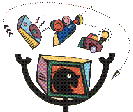
ISO/IEC JTC1/SC29/WG12
Multimedia and Hypermedia information coding
Expert Group (MHEG)
 |
|
| Date: | March 1999 |
| Source: | Chris Dobbyn, Oxford Brookes University, David Shrimpton, University of Kent at Canterbury, Tom Casey, Visiting Research Fellow, Oxford Brookes University |
| Title: | Models of Convergence between the World Wide Web and Interactive Television using MHEG-5: |
| Status: | Paper for presentation at: Third IASTED/ISMM Conference on Internet and Multimedia Systems and Applications (IMSA '99) |
| Requested Action: | Review for discussion at Seoul meeting on MHEG-XML requirements |
| Distribution: | MHEG Members, Mail list reflectors and http://www.mheg.org |
Models of Convergence between the World Wide Web and Interactive Television using MHEG-5:
Chris Dobbyn, Oxford Brookes University, Oxford, UK,
Tel: ++44 (0)1865 483673, E-mail: c.dobbyn@brookes.ac.uk
David Shrimpton, University of Kent at Canterbury, Canterbury, UK, Tel: ++44 (0)1227
823532 E-mail: d.h.shrimpton@ukc.ac.uk
Tom Casey, Visiting Research Fellow, Oxford Brookes University, UK, Tel: +44 (0)171 383
5257 E-mail: tcasey@tcasey.demon.co.uk
Abstract:
There is a general consensus that the World Wide Web and Digital Interactive TV,
together with other computer features such as database access, are converging
technologies: and the question of the merger between these technologies is less a matter
of if it will happen but when and exactly how. This paper discusses possible models for
convergence and integration of the WWW and Digital ITV. The MHEG-5 ISO Standard for
final-form representation and interchange of interactive multimedia objects is introduced
and the current pattern of DTV broadcasting in the UK, which incorporates MHEG-5, is
outlined. A number of models for extending the current DTV service to enable user
interactivity, principally based on MHEG-5 and the Internet, are considered; these
extensions all entail a convergence between ITV and the WWW. MHEG-5 is proposed as
potentially pivotal to this convergence; and current work on formulating a notation for
MHEG-5 standard objects in the Extensible Mark-up Language (XML) is described, together
with a discussion of the technical issues involved in this work.
Keywords: Interactive Television (ITV), Multimedia/Hypermedia Experts Group (MHEG), Extensible Mark-up Language (XML)
1 Introduction
In this paper, we set out to
discuss various models for the convergence and integration of two rapidly expanding
technologies: that of the World Wide Web and that of Digital Television, focussing in
particular on the role that the ISO MHEG-5 Standard [1] may be able to play in this
unification.
There has been a rapid development of digital transmission technologies over the past few years. In Europe, the DVB [2] project has enabled specifications to be rapidly produced and evaluated for ratification by ETSI. One result of this activity has been the introduction of commercial Digital TV in the UK during 1998. Digital TV (DTV) not only provides higher quality picture and sound dissemination than conventional analogue TV, but also makes user interaction with the service possible: digital transmission technology allows truly interactive TV (ITV). Eventually, it seems probable that applications such as teleshopping, distance learning, multi-player games and video on demand will be integrated into the services available from a domestic television
The World Wide Web (WWW) is, of course, based on the concept of a user’s ability to interact with multimedia documents and to navigate between documents across embedded links. We believe there is a general consensus that the WWW and ITV, together with other computer features such as database access, etc., are converging technologies. It is expected, for instance, that manufacturers will include some form of HTML in set-top decoders and there are already Set-Top-Boxes (STB’s) devoted to Web browsing: Microsoft’s WebTV, which processes HTML received via a modem connection, is an example of this style of convergence of the WWW with television [3]. Moreover, TV cards can easily be fitted into PC’s equipped with Internet software and connections; and, although the technology of the Internet is not suitable for broadcasting ITV at present, much work is currently being done to develop the architectures and protocols necessary for Internet-transmitted ITV. Thus, it seems that the question of convergence between these technologies is no longer if it will happen but when and exactly how.
In Section 2, of this paper we outline the MHEG-5 Standard, which we believe may have an important role in the confluence of ITV and the WWW. Section 3 discusses the current model of DTV in the UK in 1999, while Section 4 goes on to advance three possible paradigms for the delivery of D/ITV and considers a number of possible means by which the model of Section 3 might be amended or expanded in the light of these. In Section 5 we summarise the current discussions about the representations of MHEG-5 objects in the Extensible Mark-up Language (XML) and propose this as an important potential mechanism of WWW/ITV integration. In Section 6, we offer a number of concluding remarks.
2 MHEG
The Digital Audio and Visual
Council (DAVIC) has developed a set of specifications to enable interoperability of
digital audio-visual services such as ITV [4]. For one part of these
specifications—the interchange of multimedia/ hypermedia information—MHEG-5 was
chosen as a standard. MHEG-5 is an ISO Standard ISO/IEC /JTC1/SC 29/WG12 [5], one of a
range of multimedia/hypermedia standards originating with the Multimedia Hypermedia
Experts Group. MHEG-5 specifies a group of formats and functionality for final-form
representation, interactivity, synchronisation, and real-time presentation and interchange
of multimedia objects The standard allows the grouping of multiple media object types into
a single interchange unit, also providing support for other standardised formats, such as
MPEG and JPEG by external reference. MHEG-5 allows the specification of small, precise
subsets of these objects for simple interactive multimedia domains, such as Video on
Demand (VoD), teleshopping, etc. There are many client/server multimedia applications,
ranging from home shopping and medical patient records, to education where the MHEG-5
Standard has potential applicability; the Standard refers to such fields as Application
Domains (AD’s). A distinguishing characteristic of MHEG-5 is that it can be adopted
for many AD’s.
At source, multimedia types are grouped into an MHEG object and encoded into a special format—at present, two such formats are available, ASN-1 and EBNF Textual Notation. The encoded object is then transmitted to the client where it must be decoded by dedicated software—an MHEG Engine—which is also responsible for the presentation of the object and its subsequent modifications, as well as handling synchronisation and user interaction: facilities for such interaction are specified within the MHEG Standard in special Event, Link and Action classes. This model is summarised in Fig 1.
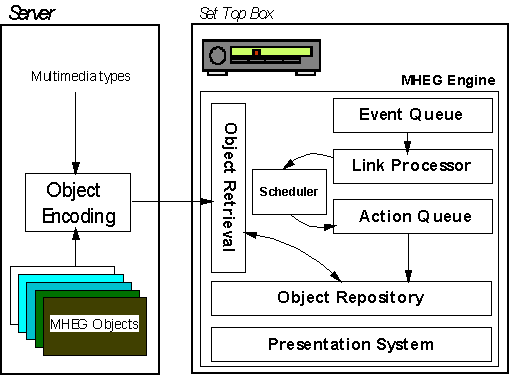
Figure 1
MHEG was designed with the need for an interpreter with as small a footprint as possible in mind. An MHEG engine would generally be required to fit into a "set top box" (STB)—although it could, of course, be implemented on any suitable computational device—consuming as few resources in terms of memory and processing power as possible, in order that the cost of the box can be kept down. Typically, applications would reside on a server, and parts of these applications would be downloaded to the MHEG engine on the client, as required.
MHEG-5 has already been adopted as a standard for DTV broadcasting in the UK and being considered for industry adoption in Japan and other European countries including Spain and Norway.
3 The
Current Digital TV Model
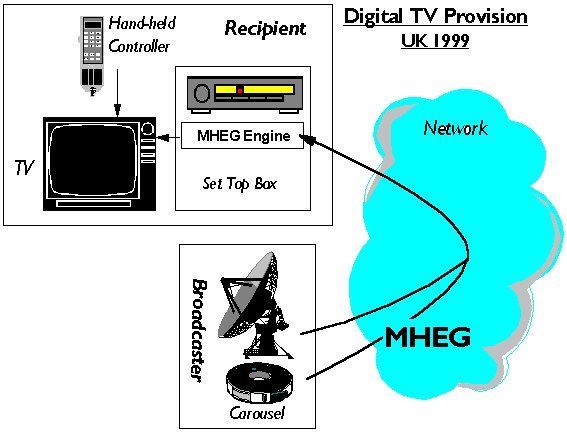
Figure 2
cable to a recipient, who will be equipped with an STB incorporating software capable of decoding the stream and rendering it into pictures or sound on a television. The broadcaster also provides a carousel—on the same principle as a teletext carousel—of MHEG-5 encoded objects, which are integrated with the digital television stream. The recipient’s STB contains an MHEG engine to which these objects are passed, after they have been separated from the stream; the engine then handles their rendering on the TV stream, together with any elementary forms of interaction that are possible within this model. Fig 3 illustrates an expanded model, not yet available, but which could quite easily be realised within existing standards, and giving a limited form of interactivity Here the STB also contains some form of internet capability, in which case web pages may be selected and retrieved from a third-party ISP by conventional means, such as a phone line, or possibly along the same cable that supplied the TV broadcast, if the recipient is so equipped. These pages may then be rendered by the STB in a number of ways—superimposed on the TV picture, presented in a separate frame, etc. The browser and the MHEG software may, or may not, be linked internally.
On this model, therefore, DTV is currently a "push" medium, without genuine interactivity, except of the most basic sort. Furthermore, the use of the carousel and the lack of any direct connection between the third party and the broadcaster severely limits the range of multimedia objects that are available to the recipient. Third parties would be expected to provide multimedia objects in MHEG format to the broadcaster for inclusion in the carousel. The third party may prepare material as MHEG objects and then supply these to the broadcaster for distribution. Alternatively, if the information provider is already preparing items for WWW distribution then these could also be sent to the broadcaster: a translation process therefore needs to occur at some point, this translation either being undertaken by the third party or by the broadcaster.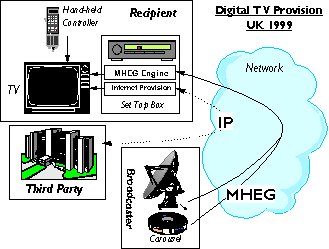
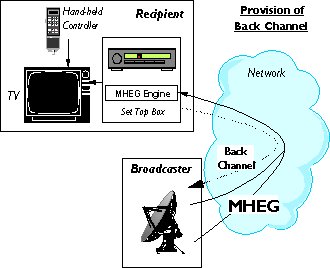
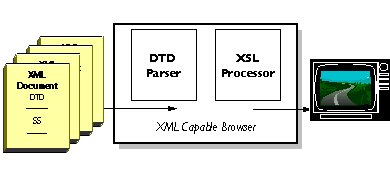
Figure 5
An MHEG-5 XML-capable engine would need facilities for retrieving, parsing and rendering conformant objects. An overview of such a system’s features is shown in Fig 6. The combined and appropriately coupled nodes: XSL, DTD, XML Parser and Browser would handle and present MHEG-5 conforming retrieved data and applications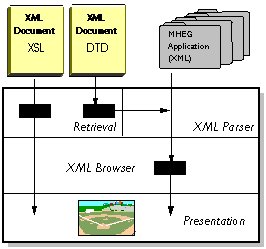
Figure 6
On the surface it would appear that to produce an XML version of MHEG-5 is not a particularly difficult task to accomplish; but a simple set of transition rules for translation from ASN.1 or EBNF textual notation to XML is not by any means the only issue, as we discuss more fully in the next section. For example, the manner in which the MHEG-5 engine is implemented and interprets the behaviour of XML expressed applications is a matter of crucial importance. Browsers are good at presentation but do not yet support synchronisation, moderately complex interactivity, event handing, and unambiguous interpretation of action features, which are an important aspect of MHEG – 5 and the engines that interpret it. These and other issues are discussed in the next section. 5.2 Discussionobtains, or whether the more modes subset relation
" X : X is MHEG-XML è X is MHEG-5
holds, at least in the initial stages of work. Price [18] points out that the subset relation may facilitate integration with the new dialects of HTML emerging from W3C, and new browsers. 5.2.3 Progressive specification
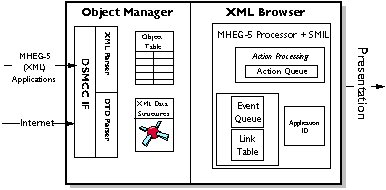
Figure 7
However, there is no general agreement on this model. Some participants [20] believe that the idea that existing XML tools can be coupled with SMIL engines and used as MHEG interpreters with minimum adaptation is simplistic; and Price [18] points out that the semantics of mark-up languages such as XML are expressed through style sheets—the MHEG-XML definition would probably follow this—whereas, the synchronisation semantics of SMIL is hard-coded into the language’s grammar; thus SMIL is not a suitable basis for the MHEG-XML studio maximum.
5.3 Conclusion